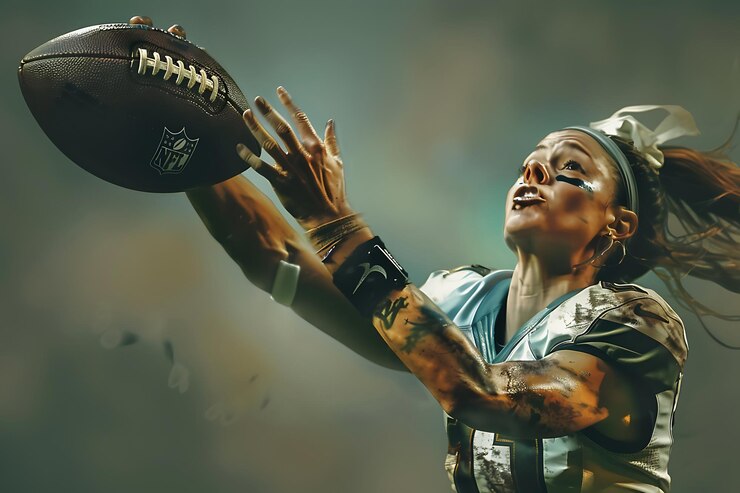The sports world is experiencing a transformative shift as women’s participation in traditionally male-dominated sports continues to rise. One significant development is the rise of the Women’s National Football League Bypass (WNFLB), a groundbreaking initiative focused on promoting women in American football. While women’s sports have grown globally in areas like soccer and basketball, American football remained one of the last strongholds of male exclusivity. The creation and expansion of the WNFLB are changing that narrative, providing a platform for women athletes to showcase their talent in a sport historically dominated by men.
The Emergence of WNFLB
This term stands out as a movement that bypasses traditional structures that have excluded women from high-level American football competitions. It seeks to create opportunities for female athletes who have long been underrepresented in the sport. This bypassing approach challenges existing leagues, which have typically limited or neglected severe female participation.
The league was formed in response to the growing demand for female participation in football and a societal push for gender equality in sports. Although there have been women’s football leagues in the past, they often faced challenges, such as a lack of sponsorship, inadequate media coverage, and fewer resources than their male counterparts. The league is designed to overcome these obstacles, offering a robust, competitive platform for women to participate in the sport professionally and with the same level of respect and visibility as men.
Breaking Gender Barriers in Football
Historically, football has been viewed as a men’s sport, with cultural, physical, and financial barriers preventing women from participating at elite levels. It addresses these issues by creating a sustainable structure supporting women athletes. It challenges the notion that football is too rough or too complex for women by proving that female athletes can excel in all aspects of the game—from strategy to physical endurance.
Women and men have embraced this effort to bypass traditional gender barriers. The success of female football players in various games demonstrates that women are not just capable of playing the game—they are capable of mastering it. The league emphasizes skill, strategy, and athleticism, levelling the playing field for all athletes regardless of gender.
The Role of Media and Sponsorship
One of the most critical elements in ensuring the success of any sports league is media coverage and sponsorship. For a long time, women’s football has struggled to garner the same attention as men’s leagues, but they have worked to change this by actively engaging with media outlets and potential sponsors. Leveraging social media platforms, livestreaming, and partnerships with sports networks, the league has grown its fan base, increased visibility, and attracted corporate sponsors.
Moreover, the rise of social media has allowed it to create content, promote games, and engage with fans directly. This direct-to-fan approach has helped create a loyal following, showcasing not only the talents of the athletes but also their stories. With increased visibility comes the potential for more significant sponsorship deals, and several companies have already expressed interest in supporting the league as it grows.
In turn, sponsorship dollars allow for better facilities, coaching, and training for athletes, ensuring that the quality of play continues to improve. This influx of support is crucial, as it ensures the league’s longevity and provides female athletes with the resources they need to compete at the highest levels.
Grassroots Development and Youth Participation
Another critical element of the success is its focus on grassroots development. Encouraging young girls to play football from an early age has been a priority, and youth leagues have been formed to develop the next generation of talent. These grassroots programs are essential for fostering a love of the game and providing young athletes with the skills they need to succeed at higher levels.
Additionally, the league’s broader strategy includes partnering with high schools and universities to create pathways for female athletes. These partnerships provide opportunities for young women to play football and establish role models within the sport. Female athletes often mentor younger players, showing them that a football career is possible and achievable.
Challenges Ahead
While this has made significant strides, challenges remain. Chief among them is the need to secure long-term sponsorships and media deals to sustain the league. Football, as a sport, requires substantial financial investment, from equipment to stadiums and travel costs. It must attract more significant sponsors who are willing to invest in women’s football as they would in men’s leagues.
Another challenge is changing societal perceptions about women in football. While progress has been made, some fans and commentators still have reservations about women’s ability to play the sport at the same level as men. To combat this, the team focuses on showcasing its players’ athletic prowess and competitiveness. It also highlights the stories of individual athletes, many of whom have overcome significant obstacles to pursue their dreams.
The Future of WNFLB
Looking ahead, the future of this is bright. As awareness about the league continues to grow, so does its potential for expansion. The league plans to expand geographically, adding more teams in different regions to increase the sport’s reach. Moreover, collaborations with existing women’s sports organizations could help elevate the profile, creating a broader platform for female athletes across multiple sports.
Its rise also reflects a broader trend in women’s sports, where leagues and athletes demand equal pay, resources, and media attention. As society becomes more inclusive, it is positioned to play a pivotal role in the movement toward gender equality in sports. The league’s athletes are already role models for young girls everywhere, proving that football is not just a man’s game.
Conclusion
The WNFLB has emerged as a transformative force in women’s sports. Breaking down traditional barriers and providing a professional platform for female athletes is changing the narrative around women in football. The league’s focus on media engagement, sponsorship, and grassroots development ensures it has the foundation to thrive. Though challenges remain, this symbolizes progress and potential for women’s football and the future of sports in general. As more people recognize the value and talent of female athletes, leagues like this will continue to flourish, inspiring future generations of women to pursue their dreams on the field.





